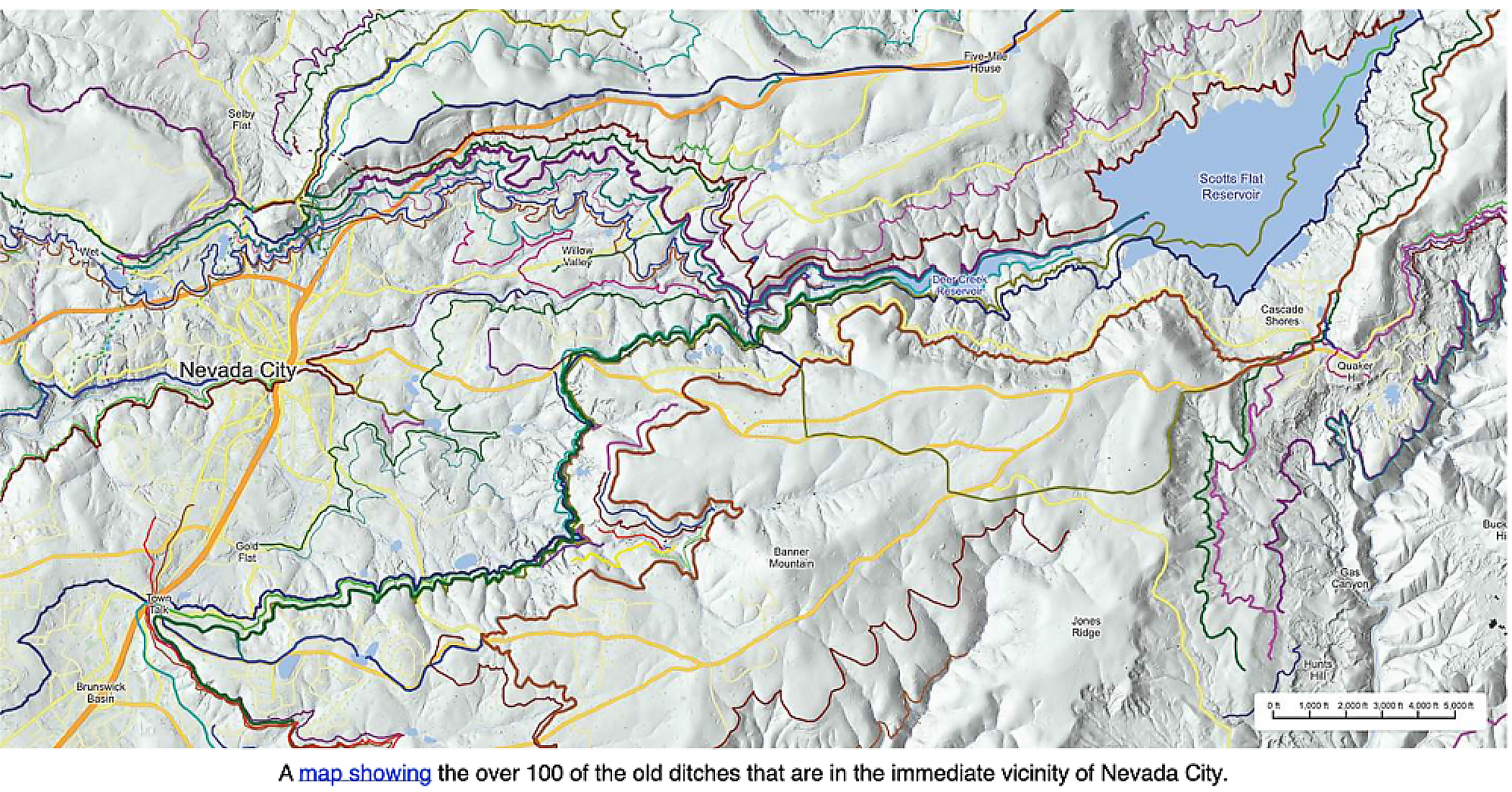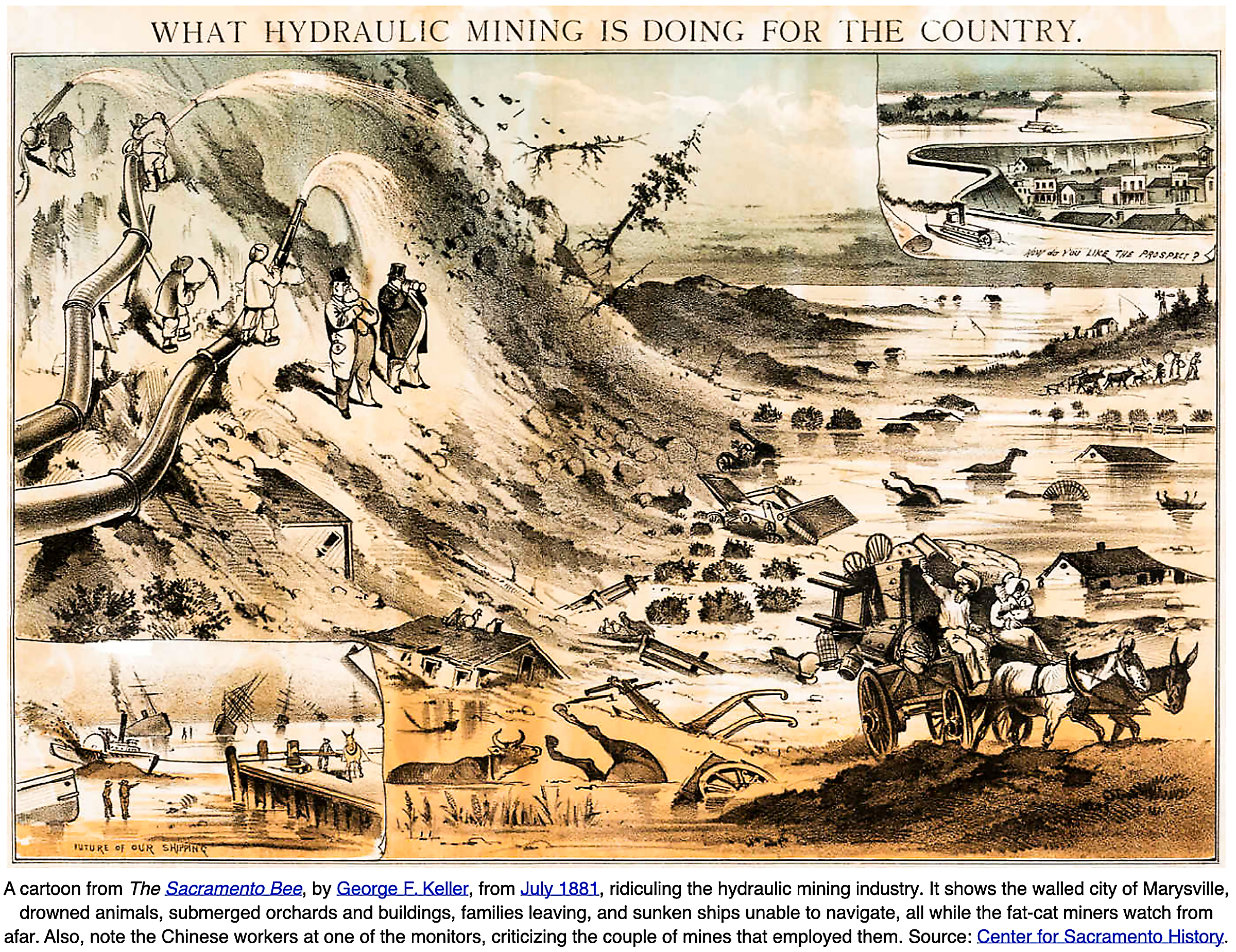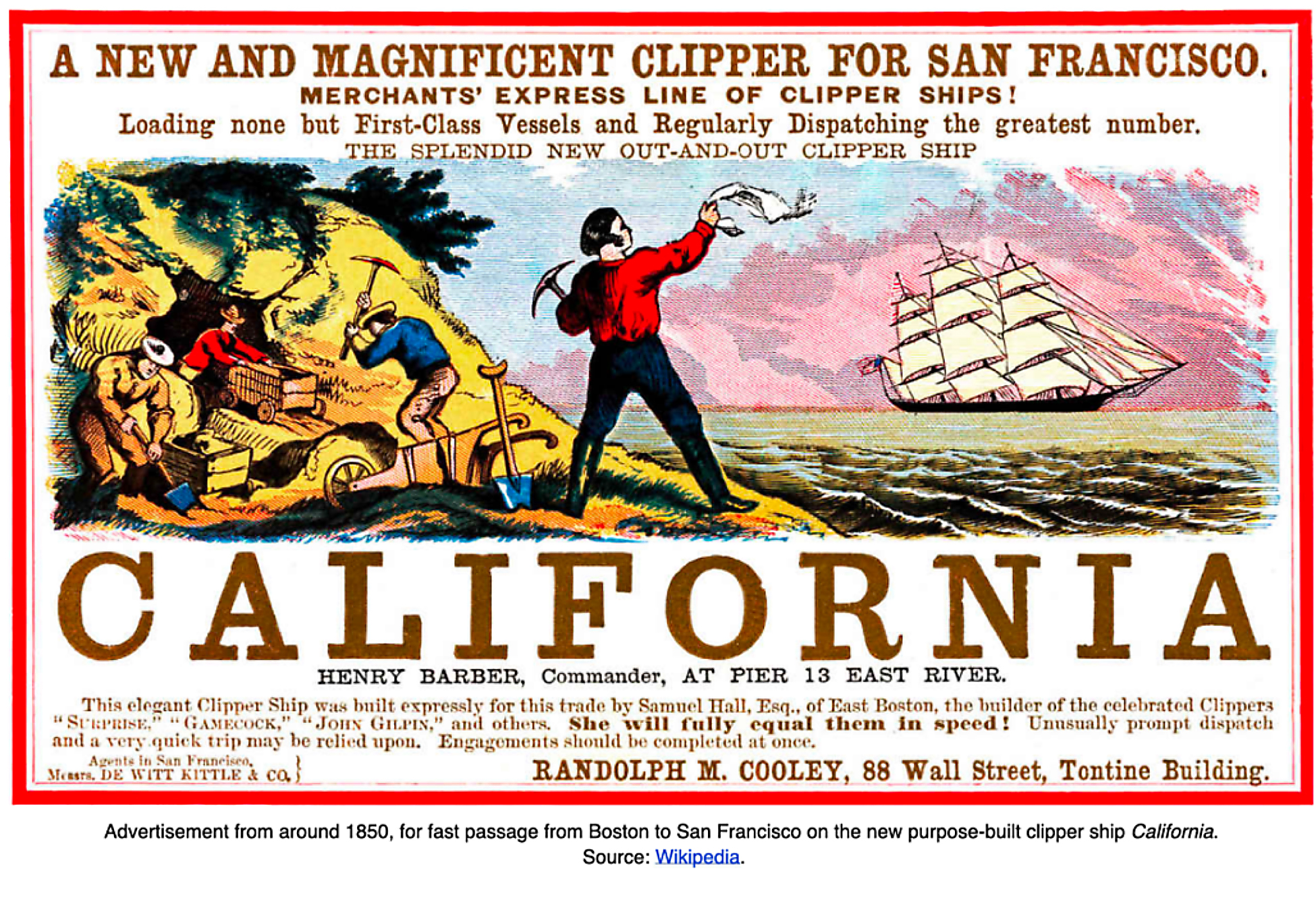The Ditches of Nevada City
The Untold Story of Nevada City’s Gold Mining Ditches, the Men Who Built them, and Their Thirst for Water and Power
884 pages large format
Dom Lindars 2023
If you’ve poked around the Sierra foothills at all, outside of driving through, you’ve come across various canals and ditches moving water. These are the successors to a major 19th Century industry in the foothills that eventually grew to hundreds of miles of ditches and canals, first for placer mining with rockers and long toms, then to hydraulic mining until that was banned, and then moving water for consumption by towns and irrigation, and finally for electrical generation. The remains of that industry are still around.

The Ditches of Nevada City is an amazing book. Its 884 pages are full of text of course, but also maps, historic and contemporary pictures, drawings, and newspaper quotes. This is probably not a book that you’ll try to read straight through, even though that’s what our book reviewers did. It is more of a reference book if you are interested in the canals and ditches or something you’d pick up to read short sections at a time. One of the strengths of the book are the biographies that pop up from time to time. Here the history is humanized as the stories of various local pioneers are told. Some of the biographies are quite captivating.
Some Heirloom readers will be wondering about now why we have a review about Nevada City history which is far removed from Donner Summit. First, this book deserves it for the amazing amount of research that went into it. Here’s just one example of how thorough Mr. Lindars was in his writing.
Charles Marsh is one of the biographies in the book. He built ditches, developed the first town water supply which included fire hydrants was one of the founders of the CPRR, worked with several water companies and commercial endeavors, belonged to various civic organizations, etc. The author included a picture of Marsh’s house in Nevada City and one portrait of Marsh. We’d expect that. Then there is a picture of the Promontory Point, Utah at the driving of the golden spike in 1869. Lindars found Marsh in the crowd of hundreds and circled him in red.
This book is also in the Heirloom because there is a connection to Donner Summit. To begin with the ditches were filled with water collected locally around Nevada City. As demand grew though, water companies moved up the mountain for new sources. The biggest water company was the So. Yuba Canal Co. The company owned a number of lakes on Donner Summit which impounded water in the winter and spring which was then released to run into the south Yuba River, then into Lake Spaulding and finally into ditches from the Spaulding dam to Nevada City and surroundings. As water was release from Spaulding it was also released from Kidd, Cascade, Devil’s, and Van Norden Lakes providing continuity of the flow for downstream. In the case of Van Norden as the water receded in the summer the grasses grew providing fodder for the sheep that arrived to the mountain meadow in late summer. The final connection to the water system is Kidd Lake, named for one of the principals of the So. Yuba Water Co., G.W. Kidd (see the August ’23 Heirloom).
The 19th Century was the “Golden Age of ditch construction.” According to Governor Bigler in 1856, "vast canals have been constructed, ditches dug, dams built, and water-courses turned. This book delves into every one of the canals and ditches providing maps of each, a diagram of the size, who built the ditches and canals for whom, and for how much, and any relevant court cases. Given the number of ditches and canals it boggles the mind that so much detail could be collected.
To get an idea of the comprehensive research that went into this book, the preface says, “The 75 maps and paths of over 200 ditches included in this book are based on more than 12,000 GPS reference points I took in the field and then nearly 100,000 hand-drawn points to trace 790 miles of all the old ditches. This does not include any of the Nevada Irrigation District's (NID) 461 miles of modern canal.” See the comprehensive map of ditches and canals here.
Then the author, Dom Lindars, says, “Hidden in the shelves of the Searls Historical Library (the archive of the Nevada County Historical Society) and tightly folded up in legal binders are thousands of pages of handwritten courtroom testimony from lawsuits from the late 1850s and 1860s. After photographing hundreds of those pages and spending days of careful transcription and annotating, I was able to piece together the full story of nearly every ditch I had found. The tales extracted from the important ditch trials created a framework for this book. Then, as I meticulously cross-referenced these basics with thousands of newspaper articles, plus genealogical records from Ancestry.com, the full story of the ditches, and the people who worked on them, were revealed.”
The book starts with brief but lucid historical and geological background of California as well as prospecting in the Nevada City and wider area making use of quotes and visuals photographs. Interesting facts add to the story for example that at one time Nevada City was “the third largest city in California, after San Francisco and Sacramento.”
To enliven the facts there are interesting quotes about life at the time. Benjamin P. Avery, later one of the editors of the San Francisco Daily Evening Bulletin, was prospecting there at the time. In 1856 he wrote, “In October 1849, I arrived at Caldwell's store, the only trading post on Deer Creek at that time. I found it a square canvas shanty, stocked with whisky, pork, mouldy biscuit and ginger bread; the whisky four bits a drink, the biscuits a dollar a pound.”
 Because much of the gold was found “beyond the river sandbars and creeks beds” and In fact, most deposits were not close to running water” miners first had to haul their dirt to the water. The book is about bringing the water to the dirt via ditches and canals (and even a few flumes). This is what the author has been working on and rediscovered “through painstaking research combined with GPS surveying and a little software engineering.” He rediscovered the ditches and the stories that went with them.
Because much of the gold was found “beyond the river sandbars and creeks beds” and In fact, most deposits were not close to running water” miners first had to haul their dirt to the water. The book is about bringing the water to the dirt via ditches and canals (and even a few flumes). This is what the author has been working on and rediscovered “through painstaking research combined with GPS surveying and a little software engineering.” He rediscovered the ditches and the stories that went with them.
The water in the ditches served Long Toms. The winter of 1849-50 was heavy and so there was plenty of water but the following years brought drought which meant more ditches carrying more water. This brought the construction of reservoirs to supply the ditches and keep them running. Here we get a lot of information about ditches.
We also get a lot of quotes about life at the time and the disappointments of many. Echoing the sentiments of many Nevada City miners, Eli Cook, in a letter to his wife on January 25, 1851, wrote: “There has been a good many new discoveries & rich mines higher up in the Mountains and will be a great rush to them in the spring. In fact the whole country is full of gold but takes time to find it and hard work to get it out. A great many become discouraged and say if they had money to take them home they would go.
“But I think in a country where a man can [get] 5 or 6 dollar a day for common labor is not the worst in the world. However I would advise no one who is comfortable at home to come to this country. He might be disappointed and blame me if I should so advise him.”
Peter Decker, on December 6, 1850, echoed the miners' sentiment and his quote; “Many people have left and are daily leaving for other diggings. Feather River [in the Sacramento Valley] and vicinity will next spring be the place for thousands to crowd to and who can foretell the fate or doom of overdone Nevada. Houses were built without number and now no house in town would bring a third of the original cost. All, or nearly so, are labeled "For Sale" or ‘To Let’, etc.”
Later in 1867, Edwin Bean summarized the situation: “Without water from the clouds the ditches could furnish but little. A dry season was, to use an Irishism, the rainy season of 1850-51. Hundreds of miners became disgusted and left the place. There was general depression, goods went down in price, and merchants ‘went up’ for all they were worth.”
Gold mining techniques and their efficiencies are also covered: panning, rocker or cradle, Long Tom, sluice boxes, and then hydraulic mining and then the various improvements of the latter.
Each ditch or canal has its own story and Lindars tells them all and these include fights over water rights, who gets to build what where and who controls what, arguments over monopoly, contemporary racism, the effects of hydraulic mining and its end (a particularly interesting section), the dawn of electricity, the burning of Nevada City every couple of years (and human nature’s part in preventing solutions for years) and eventual solutions.
The biographies are a strength of the book. All of the short biographies are interesting, humanizing the history for example this story about Aaron Sargent:
He “became worried that his promotion of Whig policies would get him into trouble with the enthusiastic and vocal southern Democrats of the Young America newspaper started by William Morris Stewart. Bob Davidge, its editor, threatened to shoot Sargent because of his views. This was technically, after all, still the Wild West. Stewart had warned Davidge off, calling Sargent ‘the most dangerous man in town to fool with.’ As a crowd gathered, Aaron's friend, Nevada County judge David Belden, stepped up and drew his pistol and said he wanted to demonstrate his shooting skills. Belden shot rapidly at various card targets, emptying his gun and hitting a card with each bullet. Finally, he announced that as a single man with nothing to lose, he would be happy to talk to anyone who didn't like Aaron Sargent. This was the end of any talk of violence against Sargent and the words of the Nevada Journal. Davidge later had the dubious distinction of having deserted from both the Union and Confederate armies during the Civil War. He died in February 1864, while rotting in prison in Nashville for murder and desertion.” That’s fun stuff.
The book is available as an e book for Kindles at $49.95 and perhaps by the time this appears in the Heirloom the hard copy will be available (149.95)


